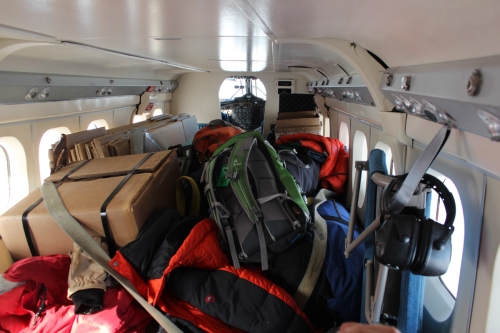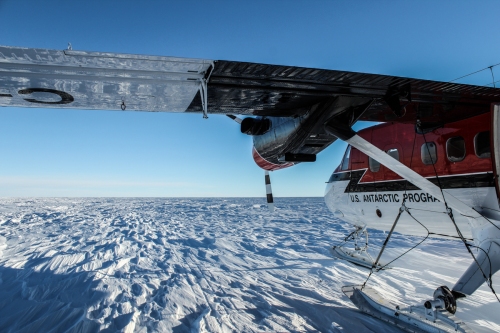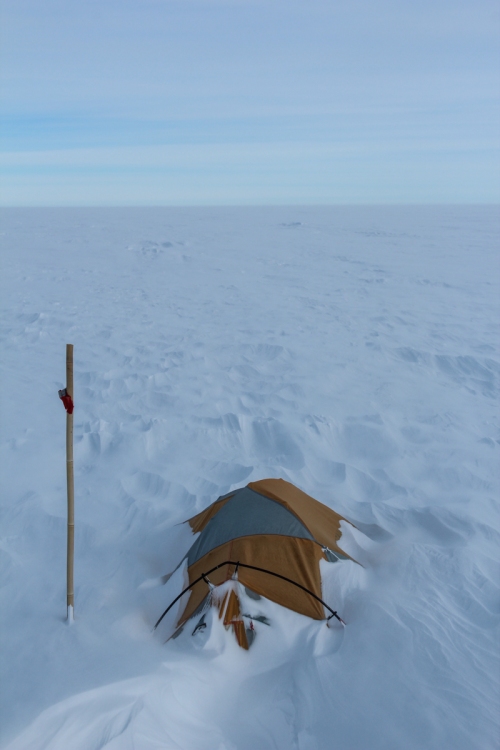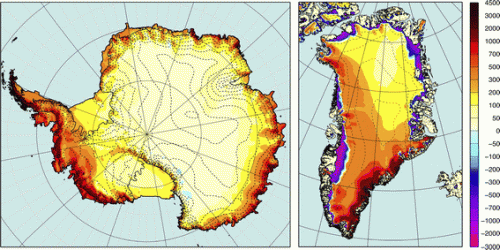The Antarctic summer has come to an end wrapping up another successful and interesting season.
This year I was working as part of the WAS (West Antarctic Support) Traverse. Operating Tucker Sno-cats and Caterpillar Challenger 55 tractors we assisted in the removal of over 100,000lbs of cargo from Byrd. The cargo had accumulated over the years from previous camps. Buildings, tents, equipment, and field supplies such as tools and flagged bamboo etc. were left on the berm. The plan was to fly much of it back to McMurdo for reissue, however many of the scheduled flights to West Antarctica were cancelled due to mechanical issues, weather, and flight priority changes with other operations on continent. With fewer flights the pressure was on us to haul it all back to WAIS where it could be consolidated and flown out next year.
On November 24th we boarded an LC-130 Herc and flew from McMurdo to WAIS Divide in the Deep Field. The WAIS camp staff had been there for a few days already and camp was looking good when we arrived. We set up our tents, checked on our gear, and got to work. Our first priority was getting our equipment out of the snow and in working order. Much easier said than done…

An LC-130 Herc loaded up and heading to WAIS Divide field camp

A Tucker buried under winter accumulation and drifting
It’s a fact of life out here – over winter the accumulation and drifting buries everything. Berms help, raising things on stilts is better, but there is always a lot of digging to be done come spring! This process was much easier with the D4 bulldozer…but even then it took about a day with equipment and another day by hand and hermie to clean out the crevices and melt out the engine blocks.
Once the equipment was cleared of snow we did a complete overview, conducting preventative maintenance measures such as fluid and filter changes. Then it was time to set up the sleds. Modern traverses generally use long sheets of high molecular weight (HMW) plastic to haul cargo and fuel. We use black not only because it’s much harder to lose in the flat white, but also because it absorbs solar radiation creating an ultra thin layer of melt water underneath (much like an ice skate). The overall goal is to reduce friction, thus increasing the mass that can be pulled.
Cargo can be placed directly on top of the HMW, but especially in the cold it doesn’t take much to damage the surface. Once scratched it cannot be used for fuel bladders for fear of damaging the bladders and risking a spill. A scratch is also a weak point and in the extreme cold everything becomes brittle. The HMW flexes and bends quite a lot as it moves over sastrugi, upsetting carefully stacked cargo.
Plastic pallets and vehicles are placed on the HMW while air force pallets are placed on decks. The decks, aka ‘dance floors’ or ARCs (Air Ride Cargo) are wooden platforms supported by air-filled kevlar pontoons. Secured to the HMW they protect the plastic sheets and also provide a stable platform on which cargo can be loaded.

Traverse Tucker 1 with a load of new skiway flags and and arcotherm heater for Byrd
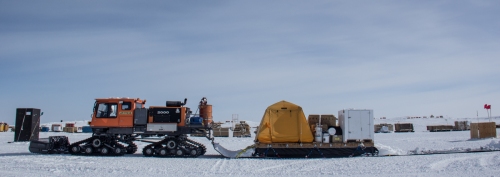
Traverse Tucker 2 with “living module” tent, food, and surival gear
By December 4th our gear was unearthed and our systems in place. The Challenger 55s required a fair bit of maintenance and repair so we took just the Tucker Sno-Cats on our first two traverses. The Tuckers can pull around 10,000 pounds each so we were limited to just two sheets of HMW. One Tucker pulled our traverse gear (an Arctic Oven tent, food, and survival gear) while the other pulled replacement skiway flags for Byrd and other gear for the WAS Recovery team.
WAIS bid us a grand farewell and we were off. It was just Tyler and I for the first few trips as our mechanic was tasked with getting the Challengers up and running. I have to admit it was exciting, heading off to drive across Antarctica from one camp to another! The whole idea of traversing in Antarctica is exciting and rich with history (as I touched on here:antarcticarctic.wordpress.com/traverses). We were not charting new territory; there have been many traverses between WAIS and Byrd. Nor were we bound to see anything other than flat white and more flat white…no mountains or icebergs or animals (except for a bird or two). Nevertheless, this was my first traverse and I was thrilled!

Leaving WAIS

First stop for the night
We drove all day, planting flags every half-mile so that we could have something other than the GPS to look at and also to help us stay on the same path as subsequent trips would be much easier on a ‘road.’ The visibility dropped and it became disorienting to say the least. Loaded down we could only go 7-10mph and I tried to relax. With nothing else to look at I stared at the little arrow on the GPS. I tried to drive straight…but after a few moments the arrow on the GPS would swing wildly and I realized I’d somehow slipped severely from our course. From the air I’m sure it looked like a random zigzag; a weaving, wavering track from point A to point B. It was easier when the visibility was good, especially once we had old tracks and flags to follow, but even then it was amusing to drive in the rear and watch the lead tractor drift to one side then swing back to the flag and drift to the other. Uneven track tensions, weight distribution, soft snow or sastrugi and the tractor would pull to one side or the other, throwing another variable into the mix. Far more difficult than it would seem!
We stopped at 6pm to refuel and chip the ice off the equipment. Dinner was heated in our little propane-powered oven and then we climbed into our unheated sleep kits – fleece liners inside huge sleeping bags nested within bulky over-bags. It was eerily quiet once the equipment was shut off. We had a small 5K generator, but for the most part we didn’t need it. Generators or equipment of some kind is almost always running in even the smallest camps. If the wind isn’t howling you can bet on hearing the roar of the gens. Out in the flat white between camps it was silent…just the tinkling of snow being blown across the surface like crystalline sand on a beach. WAIS and Byrd are only 100miles apart, but at 7-10mph it’s a very long day. We generally took two days to complete the traverse.

Traversing across the flat white is less like a road trip by car and more like motoring across rough water in a skiff. It’s hard to steer straight and in the flat white there’s nothing to steer by. Sometimes the snow is flat and soft, and other times it’s rugged and hard. The HMW flexes and the whole load moves quite a lot. When things are tied too tight straps and HMW break, too loose and things slip and slide around, carefully stacked pallets disintegrate and fall apart. Every few hours we would take a break and a walk around to check the loads and straps.

The second trip with the 297
The WAS Recovery crew at Byrd had settled in nicely and had made major progress by the time we arrived. They had the Galley Mod opened up, heated, and in use as the galley and comms area. A yurt-like Arctic Chief tent provided an alternative heated space and an area to dry clothes and hang out, while individual Artic Oven tents were set up for sleeping. We stayed for 4 days grooming the skiway, raising flags, and excavating the berms with the Tucker blades. Then on Dec 10 it was back to WAIS. Two days to get there, a day to PM the Tuckers, unload the cargo from Byrd and load it up for our return trip, a day to shower, do laundry, and rest, and On Dec 14 it was back to Byrd. This time our load included the Caterpillar 297 skid-steerer – a dense little machine at almost 10,000lbs alone!

The Caterpillar Challenger “Drag Queen”

Returning for another load

A full load of cargo

Putting pallets from Byrd up on the WAIS winter berm
The plan was to stay at Byrd for another few days, but as soon as we arrived we received a call on the iridium phone that the Heavy Equipment Operator at WAIS had been injured. So we unloaded our sleds as fast as we could and left early the next morning. WAIS needed us back to keep camp going until they could get a replacement HEO from McMurdo and to train up the new HEOs on operating in the deep field. This time we took only one Tucker, leaving the other at Byrd so they could keep grooming and excavating. Taking turns driving we made it back to WAIS late that evening. At least we didn’t have to worry about it getting dark!
At WAIS Divide we bucketed and pushed snow, forked pallets around, groomed town and the skiway, built pallets, and loaded Hercs. Another Tucker, China Doll (the one we’d had at Byrd in 2012-13) was needed at Shackleton camp. Being most familiar with the machine, I got to drive it onto the Herc! It was fairly exciting as there was no room for error.
While at WAIS we also got an opportunity to fly out via Twin Otter to help retrieve gear from a small camp at Pirrit Hills. This site is located closer to the base of the peninsula, an area I had never before visited. Mountains appeared on the horizon and then the hills themselves appeared ahead of us. The term “hills” is misleading…it’s an epic, jagged peak rising from the glacier with razor sharp ridges and massive granite faces: Utterly awe-inspiring.
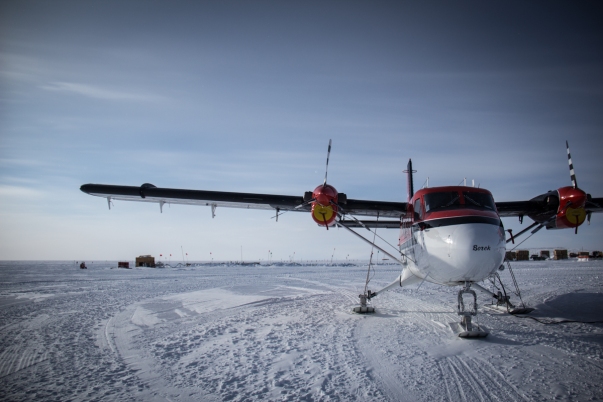

The Twin Otter

The impressive “hills” rise several thousand feet from the surrounding ice.
We spent two weeks at WAIS helping with camp operations and training up the new Heavy Equipment Operators. On December 31 it was time to leave again. This time we took the Tucker and one of the Challenger 55s. The Challengers can pull 70,000 pounds…7 times as much as the Tuckers. We hooked up three sheets of HMW with a “CRREL tool” and secured several decks for cargo. The New Year found on us halfway between camps, in the great, empty, flat white of West Antarctica.

The Challenger hooked up to a CRREL tool and sleds
Already into January we had our work cut out for us. Almost all the flights to Byrd were cancelled for one reason or another and every flight that cancelled meant more cargo for us to haul back on traverse. We did six traverses in three weeks, using both Challengers and a Tucker, and closed out Byrd on January 17th leaving just a few of the larger pieces on new tall berms. Byrd has a long history (…link to hx page…) and I’m sure someone will return someday. Perhaps it will be a short seasonal camp again or maybe even the eventual hub for USAP operations in the West Antarctic as it was in the 1970s and 80s. The long legacy of research and infrastructure here unfortunately means that there is quite a lot of buried stuff. Old buildings are certainly scattered beneath the surface and I am sure there is plenty of lost and buried cargo as well…rumors abound telling of lost bull dozers and shipping containers. We had a GPR (ground penetrating radar) unit with us on traverse and scouted around the Byrd area mostly checking to make sure we hadn’t lost anything from this last go around. We didn’t see anything recently buried, but there were plenty of buried items deeper down between 20-60ft. I have no way of knowing exactly what they are and I guess I never will, but it certainly is intriguing!

Returning for another load

Putting the Tuckers to use grooming the skiway

Digging out old cargo at Byrd

Ready to roll
We cleaned up the last of the pallets, sent off the WAS Recovery team via Twin Otter, and headed back on our last trip to WAIS Divide. It was late January by then as we had just a week to clean up and winterize the traverse equipment and gear. Back to McMurdo on Jan 27 and back to beautiful New Zealand on the 30th!



























